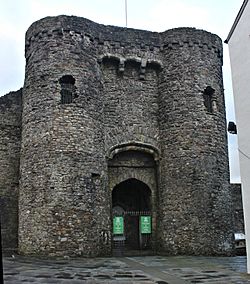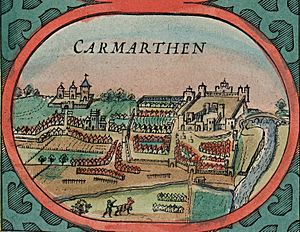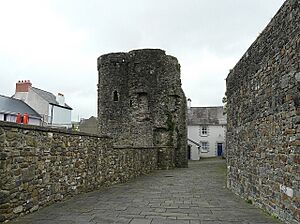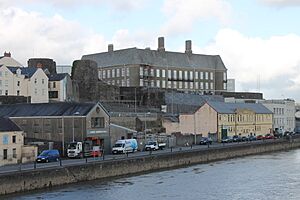Carmarthen Castle facts for kids
Quick facts for kids Carmarthen Castle |
|
|---|---|
 |
|
| Site information | |
| Condition | Ruins |
| Site history | |
| Battles/wars | Captured by Gruffydd ap Rhys (1116) Captured by Cadell ap Gruffydd (1146) |
| Type: | Grade I listed |
| Designated: | 1954 |
Carmarthen Castle (in Welsh: Castell Caerfyrddin) is a castle that is now in ruins. You can find it in Carmarthen, West Wales, UK. It was first built around the early 1100s. Over the years, the castle was captured and destroyed many times. It was rebuilt with strong stone walls in the 1190s.
A famous Welsh leader, Owain Glyndŵr, took the castle in 1405. Later, in 1456, the father of King Henry VII died there. During the Civil War, the castle was taken by Parliament's army. It was then taken apart by order of Oliver Cromwell in the mid-1600s.
For a long time, until the 1920s, Carmarthen Castle was used as the town's prison. Today, the castle ruins are a Grade I heritage site. It's a popular place for tourists and also has the town's Tourist Information Centre.
Contents
Where is Carmarthen Castle?
This castle is in the main town of Carmarthen. It sits on a high spot, about 20 meters (66 feet) above sea level. From here, you can see the River Towy. The Carmarthen Bridge is just below the castle. This was the lowest point where people could cross the river, about 11 miles (18 km) from the sea.
Even though much of it is gone, the castle has always shaped the town. The streets and property lines still spread out from where the castle stands. You can visit the castle today through its old gatehouse on Nott Square. There's also an entrance at the Old Castle Gaol on Gaol Hill.
The Castle's Long History
The First Castle
The first castle in Carmarthen was built around 1104 to 1109. It was likely built by Walter of Gloucester. Before this, an earlier fort was built about 1.4 kilometers (0.9 miles) south of here. That fort was built by William FitzBaldwin for King William II.
The very first castle was made of timber. It was a "motte and bailey" type, meaning it had a mound (motte) with a tower and a fenced area (bailey). People think it was rebuilt with stone walls later in the 1100s.
Battles in the 12th Century
It wasn't long before Gruffydd ap Rhys, a Welsh prince, attacked Carmarthen Castle. His lands had been taken by the Normans. Around 1116, he successfully captured the castle in a night attack. Gruffydd then took the castle apart and robbed the town nearby.
After being rebuilt, the castle was captured many times over the next few decades. Owain Gwynedd, a prince from North Wales, destroyed the castle in 1137. It was destroyed again in 1143. In 1146, Cadell ap Gruffydd, Gruffydd ap Rhys's son, captured it and held it for several years. Later, Cadell's brother Rhys ap Gruffydd captured and destroyed the castle again in 1195.
The Wars of the Roses
Carmarthen Castle is known as the place where Edmund Tudor died. He was the father of Henry VII, who became the first Tudor king of England. Edmund took control of the castle during the Wars of the Roses. He was fighting for the House of Lancaster.
In August 1456, soldiers from the Yorkist side captured the castle. They were led by William Herbert. Edmund Tudor was taken prisoner and died there on November 1st. His wife, Margaret, was 13 years old. She gave birth to Henry in January of the next year.
The Old Prison
The castle had a prison with eight cells in its inner area. In 1789, this was turned into a new county prison. An architect named John Nash designed it. The prison was made bigger in 1869. It was used until it was torn down in 1936.
Around 1860, a two-story police station was built between the castle's outer and inner walls. It was used to hold people who were being moved to the nearby courthouse. This building was used until 1947 and is now called Castle House.
Carmarthen Castle Today
After it was no longer used as a prison, Carmarthenshire Council bought the Old Gaol in 1925. They wanted to build a new County Hall and a museum there. The new County Hall was finished in 1938.
The parts of Carmarthen Castle that are left have been a Grade I heritage site since 1954. This means they are important historical remains.
In the early 2000s, some parts of the castle were made open to the public. These included the Square Tower and Southwest Tower. Some buildings around the castle were removed so people could see it better. In 2003, the upper parts of the gatehouse and the shell keep were opened for the first time. A grassy area with benches was also created at the top of the keep's mound. From here, you can enjoy views over the town.
Today, Castle House, which is inside the castle walls, is used as a museum. It also serves as the town's Tourist Information Centre.
Images for kids






